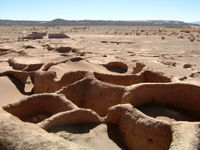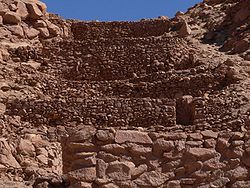
Atacameño
Encyclopedia


Indigenous peoples of the Americas
The indigenous peoples of the Americas are the pre-Columbian inhabitants of North and South America, their descendants and other ethnic groups who are identified with those peoples. Indigenous peoples are known in Canada as Aboriginal peoples, and in the United States as Native Americans...
people who inhabited the Andean
Andes
The Andes is the world's longest continental mountain range. It is a continual range of highlands along the western coast of South America. This range is about long, about to wide , and of an average height of about .Along its length, the Andes is split into several ranges, which are separated...
portion of the Atacama Desert
Atacama Desert
The Atacama Desert is a plateau in South America, covering a strip of land on the Pacific coast, west of the Andes mountains. It is, according to NASA, National Geographic and many other publications, the driest desert in the world...
, mainly in what is today Chile's Antofagasta Region
Antofagasta Region
The II Antofagasta Region is one of Chile's fifteen first-order administrative divisions. It comprises three provinces, Antofagasta, El Loa and Tocopilla...
. Their language is known as Kunza
Kunza
Kunza Cunza, also known as Likanantaí, Lipe, Ulipe, or Atacameño, is an extinct, unclassified language spoken in the Atacama Desert of northern Chile and southern Perú by the Lickan-antay people, who have since shifted to Spanish.The last Kunza speaker was found in 1949, although some have...
.
The most ancient people of the Atacama desert were nomadic hunters that followed herds of wild camelid
Camelid
Camelids are members of the biological family Camelidae, the only living family in the suborder Tylopoda. Dromedaries, Bactrian Camels, llamas, alpacas, vicuñas, and guanacos are in this group....
s. Later, the existence of vast herds of camelids and the better knowledge of primitive agricultural methods contributed to the development of a semi-sedentary lifestyle with seasonal movements.
Around 2000-1000 BC, the Atacameño people fully adopted the sedentary culture. At this stage, they had an economy mainly based on llama
Llama
The llama is a South American camelid, widely used as a meat and pack animal by Andean cultures since pre-Hispanic times....
breeding and maize
Maize
Maize known in many English-speaking countries as corn or mielie/mealie, is a grain domesticated by indigenous peoples in Mesoamerica in prehistoric times. The leafy stalk produces ears which contain seeds called kernels. Though technically a grain, maize kernels are used in cooking as a vegetable...
agriculture.
Between 400 BC and 100 AD, Atacameño farming reached a peak in its development, mainly in the oases of Lasana
Lasana
Lasana is a small village located northeast of the city of Calama in the Calama province of Chile's northern Antofagasta Region. It sits along the banks of the Loa River....
, Chiu-Chiu, Calama
Calama, Chile
Calama is a city and commune in the Atacama Desert in northern Chile. It is the capital of El Loa Province, part of the Antofagasta Region. Calama is one of the driest cities in the world with average annual precipitation of just . The River Loa, Chile's longest, flows through the city...
, San Pedro de Atacama
San Pedro de Atacama
San Pedro de Atacama is a Chilean town and commune in El Loa Province, Antofagasta Region. It is located east of Antofagasta, some 106 km southeast of Calama and the Chuquicamata copper mine, overlooking the Licancabur volcano. It features a significant archeological museum, the R. P...
, Peine, Tilomonte, Toconao
Toconao
Toconao is a village south of San Pedro de Atacama in the San Pedro de Atacama province of Chile's northern Antofagasta Region. It lies at an elevation of above sea level, close to the northeast margin of the Salar de Atacama....
.
About 2,000 Atacameño people remain today although nobody is known to continue to speak the Kunza language and the language is thought to have been extinct since the 1950s.

